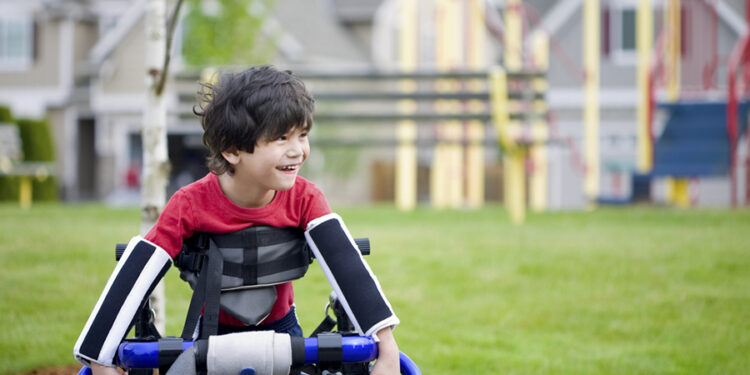Understanding Erb’s Palsy: The Early Years

Diagnosis and Initial Management
Following the diagnosis of Erb’s Palsy, parents and caregivers are often inundated with a wealth of information on Erb’s Palsy, including causes, symptoms, and therapies. The initial management phase is crucial, as it sets the foundation for the child’s future development and quality of life.
Key steps in the early management of Erb’s Palsy include:
- Establishing a comprehensive care plan with a multidisciplinary team
- Commencing physiotherapy to prevent joint stiffness and muscle atrophy
- Monitoring for any signs of respiratory complications, given the association with lung conditions
- Educating families on the condition and available support resources
It is also essential to explore legal options if the condition is a result of a birth injury. Support resources for families are invaluable, providing guidance and community connections to navigate the challenges ahead.
Physiotherapy Interventions for Infants
In the delicate early months of life, infants with Erb’s Palsy require specialized physiotherapy interventions to promote optimal physical development and prevent joint stiffness and muscle weakness. These interventions are tailored to the unique needs of each child and focus on enhancing motor function and sensory stimulation.
Key components of physiotherapy for infants with Erb’s Palsy include:
- Gentle stretching exercises to maintain joint flexibility
- Strengthening exercises to build muscle tone
- Tactile stimulation to enhance sensory awareness
- Positioning and handling techniques to encourage proper posture and movement patterns
Parents and caregivers play a crucial role in the physiotherapy process, often receiving training from therapists to continue exercises at home. Consistency and patience are vital, as progress may be gradual. The goal is to integrate these therapeutic activities into the infant’s daily routine, making them both effective and enjoyable.
Feeding and Care Challenges
Caring for an infant with Erb’s Palsy presents unique challenges, particularly when it comes to feeding and daily care. The limited range of motion and weakness in the affected arm can make traditional feeding positions difficult, necessitating creative adaptations and patience. Caregivers often need to learn specialized techniques to ensure the child receives adequate nutrition while also promoting comfort and safety.
The responsibilities of caregivers extend beyond feeding. They must also address the child’s physiologic needs, such as sleep and personal hygiene, which may be complicated by the child’s physical limitations. Additionally, caregivers face psychosocial challenges, including feelings of isolation and mental stress, as they navigate the complexities of care.
To effectively manage these challenges, caregivers may benefit from:
- Comprehensive education on Erb’s Palsy and its implications for care.
- Training on specialized feeding techniques and the use of adaptive equipment.
- Strategies for coordinating care with medical professionals and other caregivers.
- Access to support networks and resources that can provide emotional and practical assistance.
Addressing these challenges often requires a multidisciplinary approach, involving education, support, and the improvement of organizational policies to better equip caregivers for the demanding role they play in the lives of children with Erb’s Palsy.
Physical Development and Therapies
Physiotherapy for Growing Muscles and Joints
As children with Erb’s Palsy grow, their muscles and joints develop at a different pace compared to their peers. Physiotherapy plays a crucial role in supporting this development, ensuring that the affected limbs gain strength and function to the best possible extent. Tailored physiotherapy programs are designed to address the unique needs of each child, focusing on improving range of motion, muscle strength, and coordination.
Key components of physiotherapy for these children include exercises for stretching and strengthening, as well as activities that promote fine and gross motor skills. For instance, physiotherapy management for flat foot (Pes Planus) and Osgood Schlatter disease may be incorporated into the regimen for those experiencing these common associated conditions. Additionally, physiotherapy in early intervention programs is vital for children with special needs, as it lays the foundation for future physical abilities.
Moreover, physiotherapists often recommend specific exercises to prevent or manage exercise-induced muscle cramps, which are common in children with Erb’s Palsy. These exercises are not only therapeutic but also encourage active participation in physical activities, which is essential for the child’s overall well-being and social inclusion.
Managing Associated Conditions like CTEV and Scoliosis
Children with Erb’s Palsy may also face associated conditions such as Congenital Talipes Equinovarus (CTEV), commonly known as clubfoot, and scoliosis, a curvature of the spine. Addressing these conditions is crucial for the child’s overall mobility and quality of life.
For CTEV, treatment often begins soon after birth with techniques like the Ponseti method, which involves gentle manipulation and casting of the feet, followed by the use of braces to maintain correction. Consistent physiotherapy is also integral to managing CTEV, focusing on strengthening and stretching exercises to improve foot position and function.
Scoliosis management may include bracing to prevent further curvature of the spine as the child grows. In more severe cases, surgery might be considered. Physiotherapy plays a significant role in scoliosis treatment as well, with exercises tailored to enhance muscular balance and spinal alignment. Regular monitoring by healthcare professionals ensures that the interventions are effective and adjusted as the child develops.
Exercise Induced Muscle Cramps in Children
Children with Erb’s Palsy may experience muscle cramps during exercise due to the imbalance in muscle strength and coordination. These cramps can be painful and may discourage physical activity, which is essential for their development. To manage and prevent exercise-induced muscle cramps, several strategies can be employed:
- Ensuring proper hydration before, during, and after exercise to maintain muscle function.
- Incorporating a balanced diet rich in electrolytes, such as potassium and magnesium, which are crucial for muscle health.
- Gradually increasing the intensity of exercise to allow muscles to adapt and reduce the risk of cramping.
- Encouraging regular stretching and warm-up routines to prepare the muscles for activity.
It is important for caregivers and physical therapists to closely monitor the child’s response to exercise and adjust the regimen accordingly. By taking these proactive steps, children with Erb’s Palsy can enjoy the benefits of physical activity while minimizing discomfort from muscle cramps.
Communication and Social Interaction
Language Development and Speech Therapy
Children with Erb’s Palsy may face unique challenges in language development due to potential difficulties with muscle control and coordination. Speech therapy plays a crucial role in addressing these issues, helping to improve articulation, phonology, and pragmatic skills.
- Phonology: Therapists work on the sound system of language, ensuring that children can produce and understand speech sounds correctly.
- Pragmatic Skills: These are the social language skills that we use in our daily interactions with others, such as greeting, requesting, and storytelling.
Incorporating technology can be beneficial in battling stuttering and enhancing communication. Tools like cochlear implants may be considered for children with associated hearing loss, while various apps and devices support speech practice and auditory training.
Family support groups provide a platform for parents to share experiences and strategies, which is invaluable for the child’s progress. Engaging in face and mouth exercises can also be a fun way to strengthen the muscles needed for speech. It’s important to remember that every child’s journey with Erb’s Palsy is unique, and a tailored approach to speech therapy is essential for the best outcomes.
Social Challenges and Inclusion
Children with Erb’s Palsy may face a variety of social challenges that can significantly impact their well-being. These difficulties often extend beyond the physical symptoms of the condition and can affect the child’s ability to engage with peers and participate in community activities. Caregivers also encounter challenges, including discrimination, lack of support, and limited access to information, which can hinder their advocacy efforts for their child.
To foster inclusion and address these social challenges, a multifaceted approach is necessary:
- Education and Awareness: Raising awareness about Erb’s Palsy and educating peers, educators, and the community can reduce stigma and promote understanding.
- Support Networks: Establishing support groups for caregivers and children with Erb’s Palsy can provide a platform for sharing experiences and strategies.
- Policy Improvement: Advocating for changes in organizational policies can help ensure that children with Erb’s Palsy have equal opportunities.
- Multidisciplinary Care: A team approach involving healthcare providers, psychologists, and educators can address the complex needs of the child.
The effectiveness of participation-oriented interventions depends on factors such as the clinical context and the actions of clinicians. Innovative community mental health models have shown promise, but gaps remain, particularly in addressing the psychosocial aspects of living with a disability like Erb’s Palsy. Collaboration and social change are crucial in overcoming these challenges and improving the well-being of children with Erb’s Palsy and their families.
The Role of Cochlear Implants and Hearing Aids
For children with Erb’s Palsy, the integration of cochlear implants and hearing aids can be a critical component of their communication and learning toolkit. These devices not only facilitate auditory input but also enhance language development and social interaction.
- Audiologist Consultation: Regular visits to an audiologist are essential for monitoring hearing levels and ensuring that hearing aids and cochlear implants are functioning optimally.
- Auditory Training: Children may undergo auditory training to improve their ability to recognize and interpret sounds, which is especially beneficial for those with auditory neuropathy.
- Hearing Aid Care: Proper maintenance of hearing devices is crucial to prevent malfunctions and infections.
- Realistic Expectations: Parents and educators should have realistic expectations regarding the capabilities of hearing aids and understand that they are aids, not cures.
Incorporating these devices into the educational environment requires collaboration between families, audiologists, and school staff. This team approach ensures that the child receives the support needed to thrive academically and socially.
Navigating School Life with Erb’s Palsy
Educational Support and Adaptations
Children with Erb’s Palsy may face unique challenges in the classroom setting, necessitating tailored educational support and adaptations to enhance their learning experience. Key to this support is the collaboration between parents, educators, and therapists to create an inclusive environment that caters to the child’s physical limitations while promoting academic growth.
Several strategies can be implemented to assist these children:
- Ergonomic Seating and Desks: Customized furniture that supports proper posture and accommodates limited arm mobility can significantly improve comfort and accessibility.
- Assistive Technology: Tools such as voice-to-text software and adaptive keyboards can facilitate written communication for those with fine motor skill difficulties.
- Modified Curriculum: Adjustments to the curriculum may include extended time for tasks, alternative assessment methods, and tailored learning materials.
- Physical Accessibility: Ensuring the school premises are wheelchair-friendly and that all areas are accessible for children with mobility challenges.
It is also essential to address the psychosocial aspects of school life. Encouraging peer support and understanding within the classroom can foster a sense of belonging and reduce the risk of school refusal. Regular assessments and adjustments to the support plan are crucial as the child grows and their needs evolve.
Physical Education and Sports Participation
Participation in physical education and sports is a crucial aspect of school life for children with Erb’s Palsy. It not only promotes physical health but also enhances social skills and self-esteem. However, it requires careful planning and support to ensure safety and inclusivity.
- Adapted Physical Activities: Schools should provide adapted physical activities that accommodate the child’s range of motion and strength. This might include modified equipment or games tailored to the child’s abilities.
- Collaboration with Therapists: Regular communication between physical education teachers and the child’s therapists can help align school activities with therapeutic goals. This ensures a consistent approach to muscle development and joint protection.
- Peer Support: Encouraging peer support can foster an inclusive environment. Classmates can be educated about Erb’s Palsy to promote understanding and cooperation during sports and games.
It is essential to recognize the individual needs of each child and provide appropriate modifications to facilitate their full participation in physical education. By doing so, schools contribute to the holistic development of children with Erb’s Palsy, preparing them for a more active and engaged lifestyle.
Promoting Early Literacy Skills
Early literacy lays the foundation for a child’s future ability to read and write. It encompasses the knowledge children acquire about language, symbols, and storytelling before formal education begins. To foster these skills, parents and caregivers can engage in activities that promote language development and a love for reading from a young age.
- Encourage eye contact during communication to enhance engagement and understanding.
- Introduce books and storytelling to stimulate imagination and vocabulary.
- Use play as a medium for speech-language stimulation, allowing children to express ideas and emotions.
Building a positive self-image is crucial for children’s literacy development. Recognizing and nurturing a child’s strengths can lead to greater confidence and motivation to learn. A combination of support, counseling, and medical treatment, if necessary, can contribute to a better overall outcome in the development of early literacy skills.
Adolescence: Transitioning to Independence
Self-Care and Management of Erb’s Palsy
As adolescents with Erb’s Palsy transition towards independence, mastering self-care routines is crucial. These routines encompass a range of activities designed to maintain and improve physical function, as well as to foster autonomy.
- Daily Exercises: Consistent engagement in prescribed exercises helps to strengthen affected limbs and enhance mobility. Adolescents should be encouraged to integrate these exercises into their daily routine.
- Use of Adaptive Devices: Tools such as modified feeding utensils can empower those with Erb’s Palsy to perform tasks more efficiently and with greater ease.
- Personal Hygiene: Developing strategies for personal care, including bathing and dressing, is essential. Occupational therapists can provide guidance on techniques and adaptive equipment that can assist in these areas.
In addition to physical self-care, emotional and psychological well-being is equally important. Adolescents should have access to resources and support systems that address the emotional challenges associated with living with a physical disability. This holistic approach to self-care ensures that individuals with Erb’s Palsy are equipped with the skills and confidence needed to navigate the complexities of daily life and to embrace their journey towards independence.
Psychosocial Aspects and Peer Relationships
Adolescents with Erb’s Palsy may face unique psychosocial challenges as they navigate their relationships with peers. The desire for acceptance and the struggle with self-esteem issues can be more pronounced due to the physical limitations and visible differences they may experience. It is not uncommon for these individuals to encounter various emotional problems, such as:
- Fear and anxiety
- Depression
- Sibling rivalry
- Self-injurious behavior
These challenges can be exacerbated by the onset of puberty, which brings its own set of emotional complexities. Adolescents may require additional support to develop coping strategies and resilience. Life skills such as anger management, assertiveness, and communication skills become crucial tools for these young individuals. Managing stress effectively and fostering a positive self-image are key components in ensuring a healthy transition into adulthood.
Parenting plays a pivotal role in supporting adolescents with Erb’s Palsy. Parents can help by promoting mental health awareness, providing opportunities for social inclusion, and encouraging their children to engage in activities that enhance self-esteem. It is also beneficial for parents to acquire skills that aid in understanding and addressing the mental health needs of their children during these formative years.
Preparing for Adulthood with a Physical Disability
As individuals with Erb’s Palsy approach adulthood, mastering ambulation and transfer techniques becomes crucial for independence in daily life. These skills facilitate mobility and the ability to navigate various environments, from home to the workplace.
Toilet training and personal hygiene are also significant milestones, ensuring privacy and self-reliance. For those considering driving, a pre-driving assessment can identify the necessary adaptations to vehicles, empowering them with the freedom to travel.
Work rehabilitation programs can help in identifying suitable career paths and making necessary workplace accommodations. Engaging in leisure and recreational activities is equally important for a balanced life, promoting social connections and emotional well-being.
- Ambulation and transfer techniques
- Toilet training and personal hygiene
- Pre-driving assessment and vehicle adaptations
- Work rehabilitation and career planning
- Leisure and recreational activities
Choosing the right assistive devices, like a suitable wheelchair, can enhance mobility and comfort. Constraint Induced Movement Therapy (CIMT) may also be beneficial for some, encouraging the use of the affected limb in daily tasks. As adolescents transition to adulthood, these preparations lay the foundation for a fulfilling and autonomous life.





